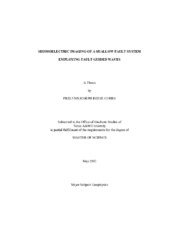| dc.contributor.advisor | Everett, Mark | |
| dc.creator | Cohrs, Frelynn Joseph Reese | |
| dc.date.accessioned | 2012-07-16T15:58:35Z | |
| dc.date.accessioned | 2012-07-16T20:25:00Z | |
| dc.date.available | 2012-07-16T15:58:35Z | |
| dc.date.available | 2012-07-16T20:25:00Z | |
| dc.date.created | 2012-05 | |
| dc.date.issued | 2012-07-16 | |
| dc.date.submitted | May 2012 | |
| dc.identifier.uri | https://hdl.handle.net/1969.1/ETD-TAMU-2012-05-11107 | |
| dc.description.abstract | Independent sets of reflection seismic and seismoelectric data were collected, processed, and interpreted with the aim of generating and studying guided waves within a fault zone. While seismic surveys have recently been utilized to investigate fault zones, past and current seismoelectric experiments have been more focused on identifying lithological interfaces and the presence of fluids within the shallow subsurface. The utilization of a fault structure to study seismoelectric conversions associated with guided waves has not hitherto been reported in the literature. The purpose of this research is to investigate the capabilities of the seismoelectric geophysical method to image fault structures, and to compare these to the capabilities of the conventional reflection seismic technique. I hypothesize that the presence of subsurface fluids will enhance seismoelectric imaging of a fault system. My results show that seismoelectric data contribute significant new for fault zone characterization and subsurface.
I collected seismic and seismoelectric data sets across a fault system in the Llano Uplift of central Texas. The seismic reflection data were collected with a Geometrics Strataview seismograph equipped with 36 geophones. The seismoelectric data utilized three Geometrics Geode seismographs, with electric fields recorded by stainless steel dipole pairs instead of geophones. A sledgehammer and an accelerated weight drop provided the seismic energy sources throughout the experiment. Elementary processing techniques were applied to both data sets to enhance the signal to noise ratio.
Seismic reflection studies previously have been shown capable of identifying fault zones through the characterization of guided waves. The seismoelectric phenomenon has not yet been utilized for this purpose. Identification of fault-zone trapped waves within each data set was attempted separately before the two data types were qualitatively compared as to their relative capabilities for illuminating the fault zone. The seismic data revealed dispersive energy packets, indicative of guided waves, within the fault zone and absent in the surrounding lithologies. The seismoelectric data was able to produce comparable signals in the fault zone showing guided waves. | en |
| dc.format.mimetype | application/pdf | |
| dc.language.iso | en_US | |
| dc.subject | Seismoelectric | en |
| dc.subject | Guided Waves | en |
| dc.title | Seismoelectric Imaging of a Shallow Fault System Employing Fault Guided Waves | en |
| dc.type | Thesis | en |
| thesis.degree.department | Geology and Geophysics | en |
| thesis.degree.discipline | Geophysics | en |
| thesis.degree.grantor | Texas A&M University | en |
| thesis.degree.name | Master of Science | en |
| thesis.degree.level | Masters | en |
| dc.contributor.committeeMember | Medina-Cetina, Zenon | |
| dc.contributor.committeeMember | Gibson, Rick | |
| dc.type.genre | thesis | en |
| dc.type.material | text | en |


